 Estonian oil shale industry is a child of wars and crises. In the beginning, during
World War I, Estonian oil shale was used in Petrograd as a surrogate of coal. A potent method
for shale oil processing was developed in the 1930's, during The First Estonian Republic.
Thanks to oil shale, Estonia became independent of foreign fuel and power. Up to World War II,
Estonian oil shale mining growth matched the development of shale oil processing. The cement
industry started using oil shale to improve the quality and economy of production. Oil shale
processing products became some of Estonia's essential export items. The oil shale products and
shale oil accounted for 8 per cent of Estonian exports (Fig. 1).
Estonian oil shale industry is a child of wars and crises. In the beginning, during
World War I, Estonian oil shale was used in Petrograd as a surrogate of coal. A potent method
for shale oil processing was developed in the 1930's, during The First Estonian Republic.
Thanks to oil shale, Estonia became independent of foreign fuel and power. Up to World War II,
Estonian oil shale mining growth matched the development of shale oil processing. The cement
industry started using oil shale to improve the quality and economy of production. Oil shale
processing products became some of Estonia's essential export items. The oil shale products and
shale oil accounted for 8 per cent of Estonian exports (Fig. 1).
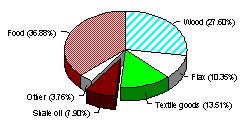
Fig. 1. Estonian export in 1939 (9 months) |
After the World War II, the soviet authorities immediately started to develop shale oil processing, mostly for the Baltic Sea Navy and gas generation for the city of Leningrad. The centralstation electric power industry started in Estonia in the 1950's. Oil shale mining production reached its maximum level of 31.35 × 106 tonnes per year in 1980 (Fig. 2).
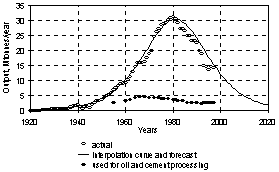
Fig. 2. Estonian oil shale mining production in 1920-2020: 1 - actual; 2 - interpolation curve and forecast; 3 - used for oil and cement processing |
After the 80's there was a steady decline in mining. The first scientific
prognoses of the inescapable decrease in oil shale mining were published in 1988. According to
this, the Estonian oil shale industry would vanish in the third decade of the next century. |
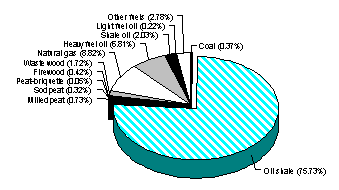 A |
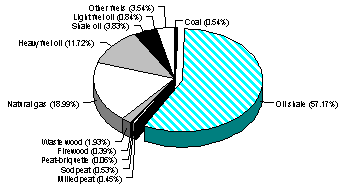 B |
| Fig. 3. Estonian production and consumption of fuels in 1997: A - heating value; B - economic value | |
Oil shale is the cheapest fuel in Estonia. Nowadays, oil shale provides an essential
part of the fuel supply in Estonia because it is considerably cheaper than other fuels (Fig. 4).
Oil shale costs EEK 12.16 per GJ. At the same time, coal costs EEK 23.41 per GJ and peat costs
EEK 14.80 per GJ (year 1997).
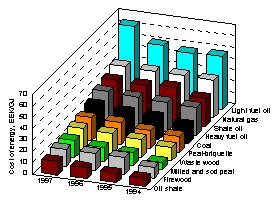
Fig. 4. Cost of fuels energy |
There are three important customers of oil shale (Fig. 5): the electric
power company Eesti Energia, the oil processing company Kiviter and the factory Kunda Nordic
Cement. In 1995, the power company utilised 81 per cent of the oil shale mass and 77 per cent
of its heating value. The balance was utilised mainly by the processing company (16 per cent of
the mass and 21 per cent of the heating value). The cement factory and others had a small part
of the oil shale market, approximately 2.3 per cent of the mass and heating value.
The state energy policy inhibits increases in the oil shale price even
though the mining infrastructure is decaying. Government price policies subside oil shale
processing.
The energy of oil shale for oil processing is 1.9 times cheaper than the
heating value of raw oil shale for power stations (Fig. 6).
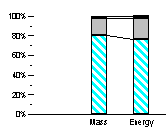 Fig. 5. Oil shale consump-tion, mass versus energy |
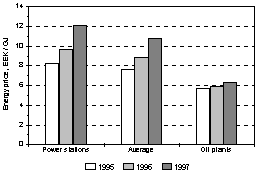
Fig. 6. Energy price of oil shale |
It could be considered as a state subsidisation of oil and cement
export at the expense of electricity. The subsidy assigned to oil processing was of EEK
124 × 106 and to the cement industry of EEK 8.4 × 106 in year
1997 (based on heating value). State regulation of prices and subsidization of oil processing
is normal for the state as for an owner of all oil shale industry. Electricity is relatively
cheap and the mining company has a possibility for producing concentrated oil shale for
processing as a by-product. Particularly the mining company is interested in cash flow and
agrees with cheaper trade oil shale concentrates than cost price. The motivation of
subsidization on the State level is that the power company can not produce more electricity
than it can trade at present, but the oil plant is able to trade all produced shale oil,
including export. It is obvious that in the case of privatisation, the subsidisation of oil
processing will cease.
Power or oil industry, that's the question (Fig. 7). This question may
be set up in this way: which option is more beneficial for the Estonian Republic at the
present time and which option will best carry our natural resources to the final consumer? The
power industry is utilising the largest part of the oil shale energy, but is delivering only
11-12 per cent of the oil shale bed energy to the final consumer. The reason is great losses
in generation and distribution of electricity. The oil processing industry is also only
delivering a low 10 per cent of the oil shale deposit energy, but oil is not as high quality
of an energy form as electricity.
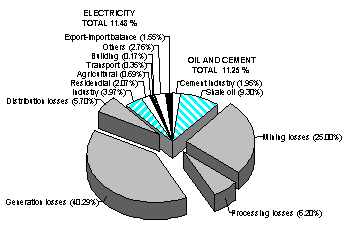
Fig. 7. Consumption of oil shale bed energy |
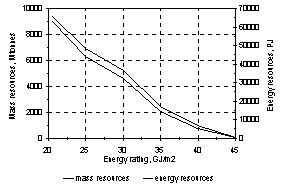
Fig. 8. Distribution of Estonian oil shale resources |
A revision has been made of oil shale reserves according to market economy conditions (Fig. 8). The bases for the prognosis is the electricity demand projection and the presumption that energy utilisation per gross domestic product must decrease significantly. One takes the energy rating of 35 GJ per m2 (about 10 MWh per m2) as a critical value for a mineable bed. Mining fields have the energy rating from 36.5 to 46.3 GJ per m2, with an average of 42.2 GJ per m2. Consequently about 20 per cent higher than minimum limit is allowed for oil shale resources. Russian oil shale resources that occurred beyond the Narva River have an energy rating below 35 GJ per m2 and, according to market economy criteria, would not have mineable reserves. Based on this new point of view, Estonian oil shale mine fields have approximately 109 tonnes of mineable reserves and exploration fields have double these reserves. |
Enno Reinsalu